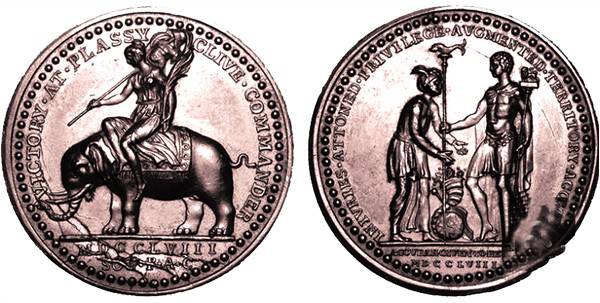
Produced by The Society for Promoting Arts and Commerce in 1758, this is the first of a number of medals to commemorate historical events. This particular medal was issued to commemorate the victory of Lord Clive at the Battle of Plassey, 1757.
This medal shows the figure of Victory bearing a trophy and palm branch, mounted upon an elephant. In Indian culture, elephants have been symbols of imperial power and prestige since Alexander the Great’s day. They are also important religious icons. Ganesh, the Hindu god of wisdom, has an elephant’s head. Robert Clive and the British adopted this much-respected emblem. Elephants were also used as weapons by Indian armies. Their thick hides and protective armour made them extremely hard to kill or injure.
Elephants were used against Clive’s forces at Plassey on June 23, 1757. That day, around 3,500 East India Company troops defeated an army of 50,000 under the French-supported Nawab of Bengal Siraj-ud-daula. He also had 50 field guns, a combination of 32-, 24- and 18-pounders. Officers on loan from the French commanded this artillery.
Lieutenant-Colonel Robert Clive was formerly a writer (clerk) before he had switched to the East India Company’s military service and his tactical flair and personal bravery had earned him rapid promotion and a great personal fortune.
His army was about 3,000-strong, including 2,100 Indian sepoys (infantry) and about 800 Europeans. The latter included the 1st Madras European Regiment and 600 Crown troops from the 39th Regiment. Clive had only ten field guns and two small howitzers.
The battle only lasted a few hours. The armies met on the banks of the Bhagirathi-Hooghly River, near the small village of Plassey (Palashi), north of Calcutta (Kolkata). The Nawab’s opening cannonade was out of range, while various skirmishes were inconclusive.
A heavy downpour of rain then interrupted proceedings. The British artillerymen quickly covered their cannon and ammunition with tarpaulins. The enemy failed to do the same and their artillery was put out of action.
The Nawab’s men moved forward, assuming that Clive’s cannon were also inoperable. They were met by a storm of fire and soon withdrew in disarray. At this point, Mir Jafar, commanding the Nawab’s cavalry, refused to take part.
By the end of the day Clive was in a position to rout the Nawab’s disheartened forces, inflicting over 500 casualties for the loss of only 22 men killed and 50 wounded.
Mir Jafar later killed Siraj and was appointed nawab in his place. But he became little more than a puppet ruler, forced to cede control of Bengal through the treaties he signed with the British. Siraj’s defeat also meant that the French were no longer a force in Bengal. The Bengal treasury allowed the Company to strengthen its military might. It was transformed from a trading company into an imperial power.
This medal shows the figure of Victory bearing a trophy and palm branch, mounted upon an elephant. In Indian culture, elephants have been symbols of imperial power and prestige since Alexander the Great’s day. They are also important religious icons. Ganesh, the Hindu god of wisdom, has an elephant’s head. Robert Clive and the British adopted this much-respected emblem. Elephants were also used as weapons by Indian armies. Their thick hides and protective armour made them extremely hard to kill or injure.
Elephants were used against Clive’s forces at Plassey on June 23, 1757. That day, around 3,500 East India Company troops defeated an army of 50,000 under the French-supported Nawab of Bengal Siraj-ud-daula. He also had 50 field guns, a combination of 32-, 24- and 18-pounders. Officers on loan from the French commanded this artillery.
Lieutenant-Colonel Robert Clive was formerly a writer (clerk) before he had switched to the East India Company’s military service and his tactical flair and personal bravery had earned him rapid promotion and a great personal fortune.
His army was about 3,000-strong, including 2,100 Indian sepoys (infantry) and about 800 Europeans. The latter included the 1st Madras European Regiment and 600 Crown troops from the 39th Regiment. Clive had only ten field guns and two small howitzers.
The battle only lasted a few hours. The armies met on the banks of the Bhagirathi-Hooghly River, near the small village of Plassey (Palashi), north of Calcutta (Kolkata). The Nawab’s opening cannonade was out of range, while various skirmishes were inconclusive.
A heavy downpour of rain then interrupted proceedings. The British artillerymen quickly covered their cannon and ammunition with tarpaulins. The enemy failed to do the same and their artillery was put out of action.
The Nawab’s men moved forward, assuming that Clive’s cannon were also inoperable. They were met by a storm of fire and soon withdrew in disarray. At this point, Mir Jafar, commanding the Nawab’s cavalry, refused to take part.
By the end of the day Clive was in a position to rout the Nawab’s disheartened forces, inflicting over 500 casualties for the loss of only 22 men killed and 50 wounded.
Mir Jafar later killed Siraj and was appointed nawab in his place. But he became little more than a puppet ruler, forced to cede control of Bengal through the treaties he signed with the British. Siraj’s defeat also meant that the French were no longer a force in Bengal. The Bengal treasury allowed the Company to strengthen its military might. It was transformed from a trading company into an imperial power.

